Cold Water Bass Fishing Complete Guide with Steps
Coldwater isn’t always a prime fishing location for many anglers. Bass anglers, on the other hand, seek coldwater to target bass in a breathtaking experience. It’s true bass slows down in colder weather but they still have to feed and it’s your job to know how to get it to choose your lures to bite on.
So, how to catch bass in colder water? To catch bass in colder water you need to search in deeper water near drop-offs, weeds, and rock piles. You need to tie crankbait, jerkbait, or swimbait to your 7-feet rod with medium-heavy action, spinning reel, and 8-pound test line.
Keep reading to access the complete guide to catching cold-water bass. If you think you’re ready to go catching bass, make sure to upgrade your gear to increase your chances of success, you can check my picks for the best bass fishing rods here.
Table of Contents
Can You Find Bass In Cold Water?

You can definitely find bass in cold water. It’s true that bass move even more slowly and eat less in colder water. Although you’re less likely to come across an aggressive bass in cold water, that doesn’t mean you can’t catch big fish.
When searching for winter bass, look for cover or structure in deeper water. Largemouth bass seeks the warmest, most stable water they can find, which is normally deeper water.
Searching for prime locations can be easier for you when you use electronics and sonar devices. Check out LUCKY Portable Fish Finder on Amazon, It helps you to cover more water in search of these fish-holding structures. It’ll also help you find schools of fish like shad that bass feed on during the winter.
For tackle, use a 7ft rod with medium-heavy action, a spinning reel that matches its weight, with a fluorocarbon 8-pound test fishing line. Use weights not lighter than 1/8 oz. and not over 1/2 oz. with a 3/0 offset worm hook or a 1/0 drop shot hook.
What’s Different In Winter?
Normally, cold-blooded animals like bass will have a faster metabolism as the water temperature increases, which will result in increasing their hunger and feeding behavior. Fish are chasing food faster and faster as the water heats up.
In the winter, the opposite is true. If the water temperature falls into the 30s, their body temperature equals that of the surrounding water. Their metabolism decreases rapidly as the water temperature drops, and so does their energy level. While the bass’s need for food reduces during this time, they continue to feed.
In warmer months, anglers focus on beating the banks and fishing shallow cover and structure for bass. In colder months, you need to be searching open water and probing the depths with deep-diving baits or vertical-jigging presentations.
Slowing down your approach and reducing the size of your baits are necessary for catching bass in the winter.
Winter Fishing Tactics for Catching Bass
Where to find Bass
Both bass and their prey congregate closely around vertical and offshore structures such as humps and rock piles in deeper lakes or ponds. Bass prefer to focus on these areas during the coldwater months so they can travel greater distances more quickly and use less energy to adjust their depth.
The second key is weeds. Small baitfish and panfish will concentrate in these areas, and the bass will follow for an easy meal. Where you find both weeds and deep waters in one place, you’ve guaranteed a productive spot.
The right depth depends on the lake you’re fishing in. If you used to fish in a lake where bass like to spend their summers at a depth of 10 feet (3 meters), cast your lures in 30 or 40 feet (9 or 12 meters) deep. If they spend their summers in 3 feet (0.3 meters) of water, head out to where it’s 10 feet (3 meters) deep.
When to fish in the day?
So, when is the best time of the day to fish for winter bass? The best time of the day to fish for winter bass is the hours between 2 p.m. and sunset. During these hours the sun has warmed up the water, the baitfish are active, and the bass are moving around to feed.
However, these hours are not your only option during winter. Dawn and early morning hours are also great if you’re willing to catch smallmouth bass. You’ll almost certainly get some bites if you’re out from an hour or two before dawn to a few minutes after the sun comes up.
Best Lures For Catching Bass In Cold Waters
Here’s a list of 5 lures you can use to get bass on the hook in cold waters:
Jerkbait

It works best for catching bass in cold waters especially when the water is clear. Bass focus on shad when the weather gets cold, and suspending jerkbait around vertical structures is a great choice.
Vary your retrieve and action when working with jerkbait. Keep it in the water longer than you usually do, the colder the water gets, the longer the pause on the jerkbait. Make sure to snap it every once in a while to imitate a real shad and catch bass’s eyes.
You can learn about jerkbait in this jerkbait vs minnows complete comparison.
Spinnerbait
Spinnerbait is your go-to not only when the water is super cold but also all year round. A spinnerbait is perhaps the most versatile bait out there. It can be used in less than a foot of water all the way down to deep-water ledges.
You can burn it, slow roll it, pump it and pause it. There are limitless ways to work your spinnerbait to catch the bass’s attention, however, when it’s too cold you need to work it steadily and slowly in deeper waters.
Pick a spinnerbait with large blades. The vibration helps the fish in locating the lure in the water. Bigger blades can have more resistance, allowing you to slow down your bait on the retrieve.
Lipless crankbait

Lipless crankbait like Red Eye Shad covers a lot of water and can be extremely effective in vegetated lakes.
Slow down your retrieve and keep the bait in contact with the bottom. Mud or grass will be whipped by the crankbait hitting the ground and floating over it, potentially resulting in further strikes from bass.
You can learn everything about crankbaits in this crankbait vs jerkbait comparison. You can also check the best crankbait rods here.
Compact jig
In 3 feet (0.9 meters) of muddy water around stumps, use a compact flipping jig, or in 5 feet (1.5 meters) of clean water, pull a compact finesse jig over a gravel bar. Small jigs have been seen to catch large bass in the winter.
Baits like the Nichols Lures FMJ24-14 are designed primarily for pitching and flipping in thick cover. Then there are the ball head and football head jigs, which are designed for pulling and have a distinct head shape and eye orientation.
Swimbait

These baits are excellent for covering deeper areas of lakes where bass tend to hang out away from the main lake structure. In lakes of big bass and big shad, try the Strike King Shadalicious in either 4 1/2- or 5-inch sizes, with the larger one being preferable.
You can learn more about swimbaits in this swimbait vs jerkbait comparison.
Flat-sided crankbait
Flat-sided crankbait is preferred by bass more than rounded-body crankbait in winter. Try using the Strike King KVD 1.5 Flat that has a long bill and no rattles for satisfying results. Throw it parallel on channel swings close to the bank in major creeks and even along bluffs, riprap, and laydowns with a steady, slow-to-medium retrieve.
What Colors Do Bass Like In The Winter?
So, what colors do bass like in the winter? Some of the colors bass like in the winter are muted chartreuse, orange, blue, yellow, black, and brown. Bass usually go for colors that imitate their forage whether it’s bluegill or shad so make sure to choose your lures accordingly.
Whether you use spinnerbait, jerkbait, crankbait, swimbait, or any other bait of your choice make sure to match the bass forage in the specific water body you’re fishing in.
How Cold Is Too Cold For Bass Fishing?
So, how cold is too cold for bass fishing? Water below 40°F (4.4°C) can be too cold for bass fishing. In extremely low temperatures, it’s more challenging to catch bass because their metabolism decreases and they don’t feed as often. It’s not impossible though, you can still catch them with a variety of techniques.
Even if bass become a little inactive during cold weather, they can still feed. Bass in the water below 40°F (4.4°C) require an easy meal. This means the angler must get the bait right in front of the bass for it to strike by choosing the right depth and the right color for the bait.
Can You Catch Bass In Extreme Cold Weather?
So, can you catch bass in extreme cold weather? Yes, you can catch bass in extreme cold weather. Bass below 40°F (4.4°C) is challenging to find and catch because they hide in deeper waters and their feeding activities drop down due to their decreased metabolism. However, they can catch your lure if you get the technique right.
If you can catch bass through the ice, you can catch it when the water is extremely cold as well. The thing is, catching them in colder water is way more challenging than catching them in a warmer one.
They’re cold-blooded creatures whose bodies imitate the water around them. So when the water is too cold, their energy level drops to the ground but luckily, they still seek a meal. They will seek an easy meal that requires no effort.
Make sure to choose the right lures, the exact depth, and the right presentation for bass to bite on your lures. You may not get the aggressive bass strike you’re hoping for, but you’ll get a huge bass on the hook.
Winter Vs Spring Cold Water Bass Fishing
Winter
While bass metabolism slows and they do not need as much food in winter, they will still strike lures. Make sure to cast jerkbait, lipless crankbait, or swimbait around the sharpest drop-offs you can find. Most bass can take shelter in covers on the bottom or suspend over points and humps.
Some of the most productive winter tactics are slowly dragging a jig over the bottom, drop-shotting, jigging a spoon, or fishing a jerkbait with long pauses. The colder the water gets, the longer the pause on the jerkbait.
Spring
Early in the spring, bass begin to migrate from deeper areas where they spent the winter to rapidly warming shallow waters. Bass will switch back and forth between shallow and deep water as the water temperature in the shallows fluctuates from day to day.
During the pre-spawn period, bass will start searching for the warmest possible water and will move into it. Shallow, stained lakes will warm the fastest, and bass will travel shallower in these waters faster than in smaller, clean lakes.
During the spawning period, bass will move to shallow waters. However, they may go deeper again if the weather started to get chilly. Lucky for you they won’t go very far. If you were successfully catching them a foot from the surface, try 5 or 10 feet for a change and you’ll get a strike.
As a helpful tip, make sure to always have a baitfish-colored square-bill crankbait ready to cast. It’s deadly to bass during springtime. It’s also a good idea to target sloping banks and wood cover with the square bill, and large flats with isolated weeds with lipless crankbaits.
Can You Catch Bass In Muddy Water?
So, can you catch bass in muddy water? Yes, you can catch bass in muddy waters. Bass likes to stay in muddy waters and use it to their advantage to hide where prey don’t see them. To find them make sure to look into the very shallow waters.
Tie on a brightly colored lure in murky or muddy water and on overcast days to improve visibility, or use a very dark solid color to enhance profile visibility. A black and blue soft plastic is best, but a white and chartreuse Glow Blade spinnerbait would be just fine.
Related Questions
At What Temperature Do Bass Start to Bite?
Bass start to bite when water temperatures are 55 to 65°F (12.7°C to 18.3°C). Bass will sometimes bite when water temperatures are extremely low in the 40’s but the process will be slower and needs a more steady and slow presentation.
What Is The Best Time of The Day To Catch Bass?
The best time of the day to catch bass is either early morning or later in the evening, at times when the sun isn’t too bright. If the weather is cloudy or the water is muddy, bass can even strike in the middle of the day.
Can Bass See Your Line?
Yes, bass can see your line. That’s why it is highly recommended to choose a line color that is as difficult as possible for bass to see. Use a clear, fluorocarbon line in clear waters and a green one in muddy waters.
Helpful Resources
Big Book of Bass: Strategies for Catching Largemouth and Smallmouth – ( you can also check it on Amazon here)
If you like this article, please share it or pin it, you can find the share buttons below. We will really appreciate it ❤️

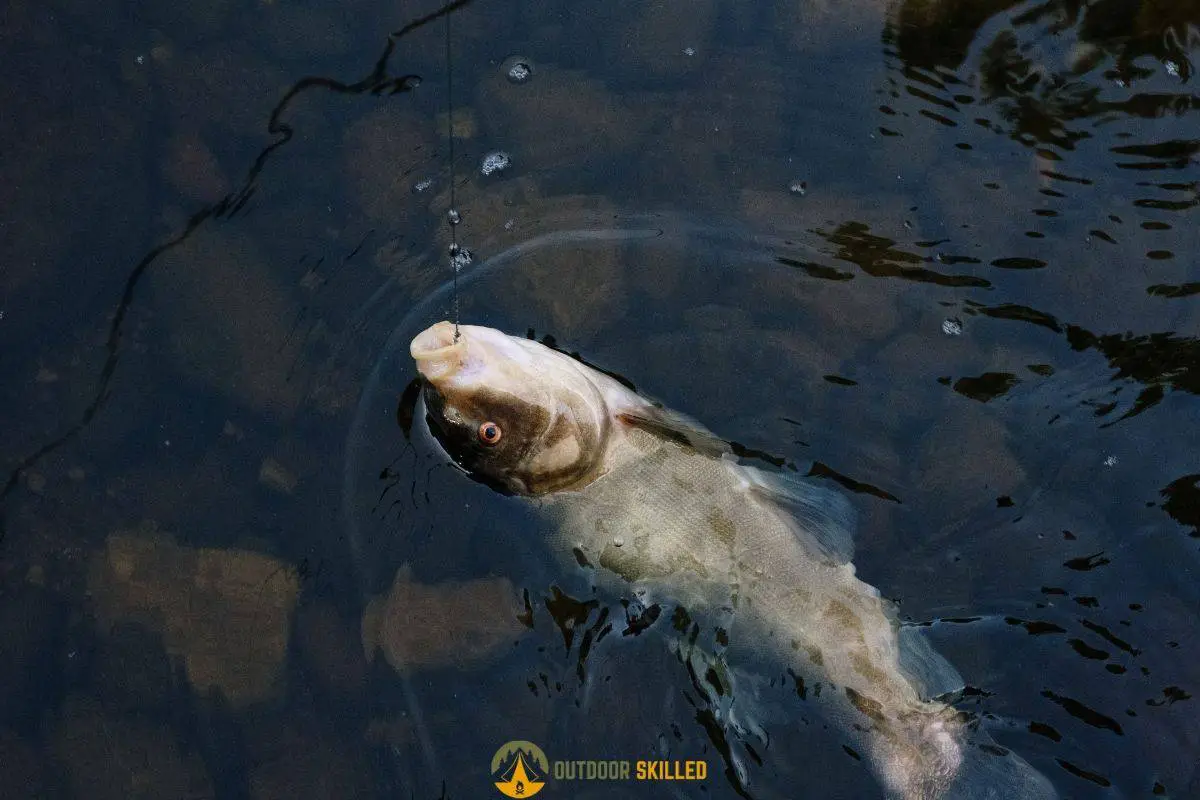
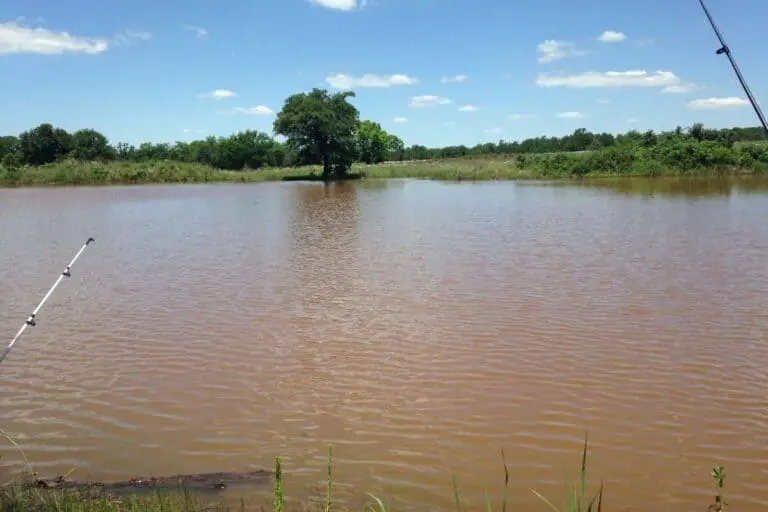

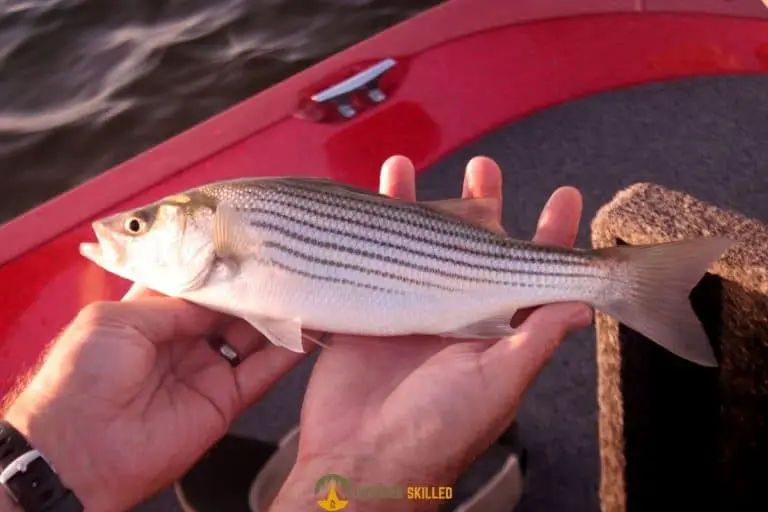
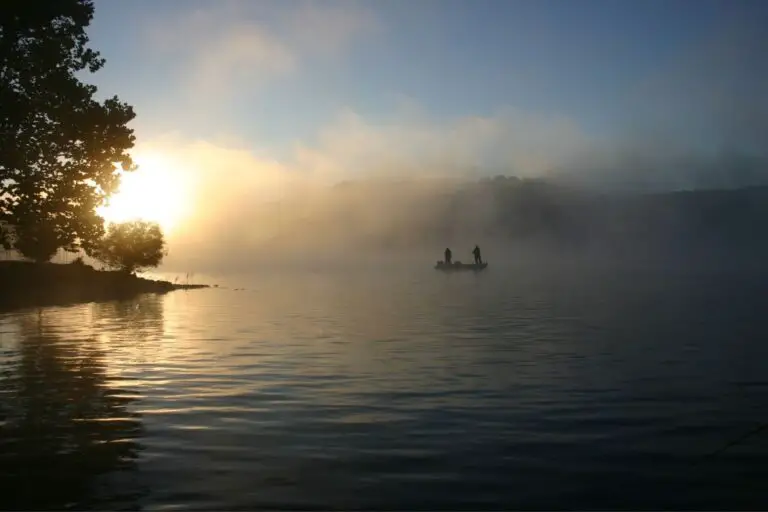
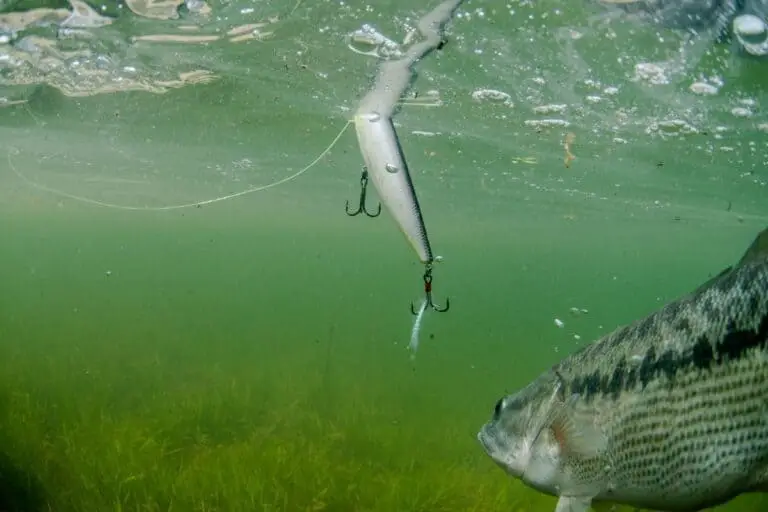
![Why Are Bass Boats So Fast? [Simply Explained]](https://outdoorskilled.com/wp-content/uploads/2021/11/bass-boat-speeding-768x512.jpeg)
